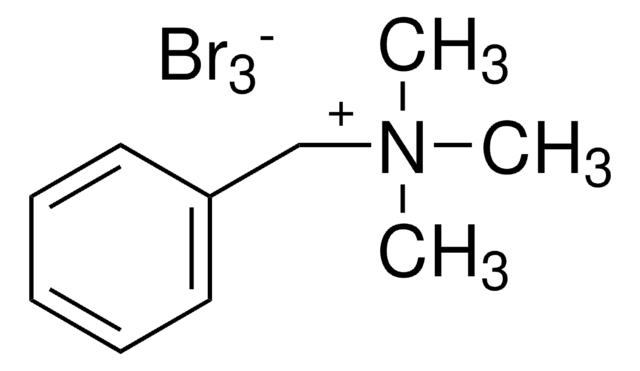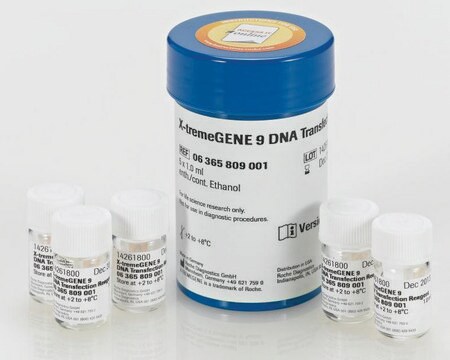11202375001
Roche
DOTAP Liposomal Transfection Reagent
>99% (TLC), liquid, suitable for transfection
Sinonimo/i:
DOTAP methosulfate, liposomal transfection reagent, dotap, transfection reagent, dotap, N-(2,3-Dioleoyloxy-1-propyl)trimethylammonium methyl sulfate, Transfection reagent
About This Item
Prodotti consigliati
Descrizione
N-[1-(2,3-Dioleoyloxy)propyl]-N,N,N-trimethylammonium methyl-sulfate
Livello qualitativo
Saggio
>99% (TLC)
Stato
liquid
Confezionamento
pkg of 5 × 400 μL (10 U/μl)
Produttore/marchio commerciale
Roche
tecniche
transfection: suitable
Temperatura di conservazione
2-8°C
Stringa SMILE
[H]C(C[N+](C)(C)C)(OC(CCCCCCC/C=C\CCCCCCCC)=O)COC(CCCCCCC/C=C\CCCCCCCC)=O.O=S([O-])(OC)=O
InChI
1S/C42H80NO4.CH4O4S/c1-6-8-10-12-14-16-18-20-22-24-26-28-30-32-34-36-41(44)46-39-40(38-43(3,4)5)47-42(45)37-35-33-31-29-27-25-23-21-19-17-15-13-11-9-7-2;1-5-6(2,3)4/h20-23,40H,6-19,24-39H2,1-5H3;1H3,(H,2,3,4)/q+1;/p-1/b22-20-,23-21-;
RSMRWWHFJMENJH-LQDDAWAPSA-M
Cerchi prodotti simili? Visita Guida al confronto tra prodotti
Categorie correlate
Descrizione generale
Applicazioni
Caratteristiche e vantaggi
- Easy to use: The lipid dispersion is simply mixed with the DNA solution, then applied directly to the cells
- Highly effective: 5 to 100-fold more effective than the calcium phosphate or DEAE-dextran method
- Gentle: No cytotoxic effects
- Flexible: Equally effective in the presence or absence of serum. Effective on a wide range of species (e.g., insect cells, mammalian cells) and a variety of different cell types. Can be used for either transient or stable transfection procedures.
- Aqueous dispersion (liposomes) in MBS (MES-buffered saline, pH 6.2) (bottled under argon), 1mg/ml, sterile-filtered.
Nota sulla preparazione
The optimal working concentration is dependent on several parameters, including the cell line being used, concentration and type of nucleic acid (DNA, RNA), and incubation time. It is important to optimize the transfection conditions for the individual cell type studied.
Cytotoxicity: Not cytotoxic up to a concentration of 100μg/ml (PBLs, HeLa cells).
Altre note
Codice della classe di stoccaggio
12 - Non Combustible Liquids
Classe di pericolosità dell'acqua (WGK)
nwg
Punto d’infiammabilità (°F)
does not flash
Punto d’infiammabilità (°C)
does not flash
Scegli una delle versioni più recenti:
Possiedi già questo prodotto?
I documenti relativi ai prodotti acquistati recentemente sono disponibili nell’Archivio dei documenti.
I clienti hanno visto anche
Articoli
This brief webinar provides an overview of what transfection is and the methods that are used to introduce DNA or RNA into eukaryotic cells.
Contenuto correlato
Browse our convenient transfection reagent selection guide to match the best reagent for your specific cell line and application needs.
Il team dei nostri ricercatori vanta grande esperienza in tutte le aree della ricerca quali Life Science, scienza dei materiali, sintesi chimica, cromatografia, discipline analitiche, ecc..
Contatta l'Assistenza Tecnica.





![Fluorescent DOTAP 1-oleoyl-2-[6-[(7-nitro-2-1,3-benzoxadiazol-4-yl)amino]hexanoyl]-3-trimethylammonium propane (chloride salt), powder](/deepweb/assets/sigmaaldrich/product/structures/262/741/3634e622-7f85-4907-beb5-5f2137c95947/640/3634e622-7f85-4907-beb5-5f2137c95947.png)







